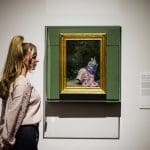
James Christensen
Following Bliss
I arrived at Jim’s home on a gray and overcast day. He was characteristically gracious and welcomed me in. Looking at the beautiful paintings that covered the walls I was transported back more than twenty years to the first time I saw a James Christensen painting. Greenwich Workshop has just released a new print entitled, Lawrence Pretended Not to Notice That a Bear Had Become Attached to His Coattails. I remember chuckling as I read James’ explanation:
 Lawrence Pretended Not to Notice that a Bear Had Become Attached to His Coattails
Lawrence Pretended Not to Notice that a Bear Had Become Attached to His Coattails
by James Christensen. Used with permission from Greenwich Workshop
(To see James C. Christensen’s latest release, click here)
“This is one of those paintings that most people can relate to. I think everyone occasionally ignores problems in hopes they will go away. We each have our own ‘bears’ we try to ignore. I remember talking with a class of third graders and I asked them what they thought Lawrence was about. One little girl said, ‘You shouldn’t take pets home without asking your mom.'”
From then until now, James Christensen has delighted all of us as we follow him on a journey of his imagination. From forests filled with fairies and fishes to islands inhabited by Shakespeare himself, Jim has transported us to worlds where the fantastical seems wonderfully commonplace. My interview would prove to be no different. By the time we finished I was waiting for a fish to come meandering through the room on its way to nowhere.
WHAT IS YOUR EARLIEST MEMORY?
As a kid whenever I heard sirens I would run to my mom and we would jump on the bike to go “find the fire.” It was just a fun thing to do and she had a little seat for me to sit on. Well, one day all of these sirens started going off and I thought, “Man, this is a big fire!”
So I went up to the front porch and yelled to my mom. She came out and said, “That’s not a fire. Those are air raid sirens. Japan has surrendered and the war is over. ”
That was 1945. I was three years old.
WERE YOUR PARENTS ARTISTIC?
My mother was artistic, but not a fine artist. My father was not artistic at all. He was always a hard worker. He worked as a butcher for a time and owned his own meat locker, then he did glazing and installed windows. He eventually became a welder for Douglas Aircraft making bombers during the war. When I was nine our next-door neighbor, who worked at a Savings and Loan, said to my dad, “You’re a bright young guy and you’ve got a lot of ambition. Would you like to come and learn how to be an appraiser?”
My father agreed and twenty-five years later he was the President of the Savings and Loan. He was a pretty amazing guy. He took night classes and ended up teaching himself.
DID YOU ALWAYS WANT TO BE AN ARTIST?
I’m not sure I always wanted to be an artist, but it was certainly there from the beginning. I remember two experiences in particular. The first came when I was quite young. They had a TV show called Disneyland and occasionally they would show this room full of old guys sitting around a table working on the next movie. One would say something like, “Now what if we had him eat a bar of soap and then he hiccups and then the bubbles came out his ears.”
When I saw that I said, “That’s what I want to do. I want to be one of those guys that make magic so I’m going to go to work for Disney and be an animator.”
 “We are, each of us, angels with only one wing. And we can only fly embracing each other.” – Luciano De Crescenzo
“We are, each of us, angels with only one wing. And we can only fly embracing each other.” – Luciano De Crescenzo
(To see James C. Christensen’s latest release, click here)
While I was a senior in high school they had a class called Senior Problems and one of the assignments was to pick a job and then find someone in that line of work and interview them. My old babysitter was an inker for MGM and she said, “I know Irving Spence, one of the head animators on Tom & Jerry. He can talk to you about what it takes to be an animator.”
So I went and spent an hour with him. He said, “I don’t know what you’re envisioning, but animation it’s not what you think. First, the creative team (those guys around the table) decides what will happen. Something like, “Start him here and then have him run to there.” The animator takes that direction and then draws the first frame and the last frame. An assistant animator does a couple of other frames in the middle and then the ‘inbetweener’ does all of the other frames – 24 per second. For the first five years you are the “inbetweener.” Then the second five years you are the Assistant Animator and another five as the Head Animator. If you last that long you eventually get to be one of the guys at the table.”
That interview threw me back out into the surf and made me stop and think about what I was going to do. I knew I didn’t want to wait that long to be one of the guys at the table and so I decided then and there I was not going to be an animator at Disney.
(To see James Christensen’s latest release, click here)
The second experience I had with art as a young person came in 1956 when the church held an open house at the Los Angeles temple.
Our family went and I remember being mesmerized at the murals. I had a feeling, even then as a thirteen-year-old boy, that this was the pinnacle of art – to paint a temple.I decided that I wanted to paint a mural for the temple someday.
I wasn’t sure that that meant, but I knew I was willing to work for that.
So yeah, I guess I always assumed I would be an artist I just didn’t see back then how it would all turn out.
WHERE DID YOU GO AFTER HIGH SCHOOL?
I went to one year at Santa Monica State College before I left on my mission to Uruguay. Then I came back and went to BYU. I didn’t go straight through because I was pursuing this young lady that I wanted to marry. She was at UCLA and so I went down there in a summer program. I was there on and off over the next couple of years until we finally married and I came back up to BYU to finish my degree.

The Bride by James Christensen.
Used with permission from Greenwich Workshop.
(To see James C. Christensen’s latest release, click here)
After my undergraduate the Y offered me a really nice deal. They offered me classes to teach if I stayed on for a graduate program. I stayed and got my Masters in Art. I didn’t get a Masters in Fine Art, that was a new degree back then and a couple of my professors said that the MFA was a “sissy” degree because you didn’t have to write a theses, you just painted. Of course now an MFA is the terminal degree.
WHERE DID YOU GO AFTER COLLEGE?
I was hired to teach art at a Junior High School in California. I tried interviewing at several colleges but I had a terrible portfolio and I really wasn’t prepared to teach at a college level. I remember one college I interviewed with asked me if I had slides I could leave. “Are you kidding?” I said, “Slides are expensive. I only have one set and I have to keep them.”
Looking back I really didn’t have anyone to mentor me. There was no one to say, “This is how you put a portfolio together and this is what you have to do to go out and compete.”
I loved my teachers. They were amazing men who shaped my philosophy, my work ethic, all of that, but they were ivory tower teachers. In fact, I remember one of my teachers whom I adored – I don’t think he sold five paintings in his lifetime. He built shelves to store them in the basement they were like his children and he wouldn’t let them go.
 The Scholar by James Christensen.
The Scholar by James Christensen.
Used with permission from Greenwich Workshop.
(To see James C. Christensen’s latest release, click here)
And so while I wanted to teach college I was not prepared. Carole was pretty clear that she wanted to live in California where it was warm and we would be close to the beach and so I applied to colleges there. Only applying in California was sort of like saying I want the bridal suite or I don’t want to stay at this hotel. Everyone wanted to teach in California and as a new guy starting out I was not going to get a college job there.
Every day I would go to the employment center at BYU to look at new job postings. This woman who saw me come in each day said, “Hey, these guys are coming from Santa Maria. It’s a Junior High School. Why don’t you go interview?”
I told her, “I don’t think so. I don’t have a teacher credential, I haven’t takes any education classes…”
Then she looked at me and said, “Well, what the hell do you have to lose? You’re not getting any younger.”
At BYU you never heard language like that and certainly not coming from a wonderful little ol’ grandma – but that was just the kick I needed and so I went and talked to Mr. Milo. After fifteen minutes he said, “We want you.”
I told him that was the nicest thing I had heard in a month, but I didn’t have a teaching credential and I was not certified. He said, “I can make that work. In California, if you have a Masters you can teach in your topic while you get certified.”
When I got home I told Carole about the offer and then said, “This is not where I wanted my life to go.”
I wanted to teach at BYU. In fact, by the time I had finished my graduate work I knew that I wanted to there. I loved the atmosphere, I loved the values, and I loved the people. We had been praying for some time about teaching at the Y, but that just wasn’t an option at that time. So here we were praying about a job in Santa Maria to teach art to Junior High students. It felt like this would take me away from what I really wanted. Little did I know what lie ahead.
The next morning we woke up and I turned to Carole and said, “I don’t get it.”
She said, “Yeah, I know. You’re going to take that job in California aren’t you?”
And so we went to California… and had a wonderful experience. In Santa Maria there was a huge ward, geographically, with about twenty percent activity. As home teachers we had almost ten families. I don’t know what it is like where you live, but when we came back to Utah they told me, “As soon as someone in the High Priests dies you’ll get a family.”
So in the space of five years I had the opportunity to teach Sunday School, work in the Young Mens Organization, Elders Quorum, and be in a Bishopric. It was those years in Santa Maria that taught me how the Church works and gave me a foundation for the rest of my life.
There was a point when I had been called as the Elders Quorum President and just I felt like I couldn’t do it. I was teaching all day, trying to paint, teaching evening classes at the college to make a little extra money, and then on top of it all do my church work.
So I decided that I needed to explain to these guys that my calling was to be an artist and I couldn’t do all the other stuff they wanted me to do… that lasted for about two hours.
I remembered a blessing I had received where I was promised if I would put the church before everything else, except family, then everything I wanted would come to pass.
So I made a decision to put the kingdom first and from that day forward the church was the priority and I gave it my best efforts.
In turn, I have watched the Lord fulfill His promises in ways I could never have imagined. He was guiding us all along the way and, while I didn’t realize it in the moment, I now see that the Lord was in it all.
WHY DID YOU STOP TEACHING JUNIOR HIGH?
I loved teaching Junior High but I could tell I was burning out.I would talk to some of the teachers that had been there for twenty years and they would say, “I teach for three reasons: June, July, and August.”
I didn’t want to get to that point. I realized that I was either going to be a mediocre Junior High teacher and a struggling artist, or I was going to be a great Junior High teacher and not an artist at all. So I quit. I was still teaching at the community college and painting like crazy. I would get the kids down, finish church stuff, and then paint from 10:00 until 1:00 in the morning. Every night. I had a few shows, but I was all over the map.
If I went to see Van Gogh I was squeezing out the paint and glopping it on. If I went to see Andrew Wyeth I was getting out the egg tempera and doing a landscape. I didn’t have any direction. I thought if I painted a little for everything then there would be something for everyone. So at the shows there were three portraits, three landscapes, three westerns, and three “poofy guys.” That didn’t work out too well.
 Poofy Guy on a Short Leash by James Christensen.
Poofy Guy on a Short Leash by James Christensen.
Used with permission from Greenwich Workshop.
(To see James C. Christensen’s latest release, click here)
I had been applying at BYU every year since I graduated. I would send in slides (I was springing for the slides by then), but a Junior High teacher without an exhibition record to speak of was just not going to get much attention. So for that whole five years no one wanted take a look at me. I prayed about it all the time and asked the Lord to make it happen, but I still wasn’t getting anywhere.
I have told my students that you have to put in the time if you want the Lord to open you the doors. I read a book a little while ago called, Outliers, and in the book the author makes the assertion that it takes 10,000 hours to truly master a skill. I figured it out one day and by the time we left Santa Maria I had put in those 10,000 hours.
The Sunday School President in my ward came to me at that time and said, “My brother-in-law is the art director of the New Era magazine. Maybe you should talk to him.”
So when we came up to Utah for Thanksgiving I brought my portfolio and I went in to see Ralph Reynolds at the New Era. I asked him if he would consider sending some free lance work my way. I got a call back that night from the editor, Brian Kelly, who said, “We’re looking for a designer and you are the answer to our prayers. Would you consider coming on full-time?”
“I’m not qualified for the job. I have never had a commercial art class and I don’t know what I am supposed to do,” I told him.
“I can teach anybody the mechanics of design, but you have imagination. I look at your portfolio and you are all over the place and that is what we are looking for. I don’t want a guy that only does one thing.”
Carole and I prayed about it and got a very strong confirmation that we should take the job. So reluctantly, we left California in January and arrived in Utah in the middle of a blizzard. I ended up working as an illustrator and designer for the New Era for the next several years. It was there that I learned graphic design.
WHEN DID YOU START TEACHING AT BYU?
The third summer in Utah I decided that I was going to stop praying about teaching at BYU. I remember saying, “Lord, I have been praying for eight years to teach at BYU. You know what I want, but if that is not to be or if you have a different path for me then I am willing to accept it. I haven’t changed my mind, but I am going to leave this in your hands.”
Up to that point I had been telling God what He ought to be doing. I wasn’t angry with God or anything, I just didn’t have the big picture yet. It was that same summer when Carole went into labor with Peter. I received a call from Bob Marshall, who told me there had been a change and he was the new Chairman of the Art Department at BYU and there was an opening to teach graphic design.He asked if I wanted to come down and interview.
Carole had the baby and in those days you stayed in the hospital for three or four days, so while she was recovering I ran down to Provo to interview. I didn’t tell her about it because I didn’t want to get her hopes up, but after the interview they offered me the job.
It was only then that I started to see the big picture. If I had kept applying to BYU as a painter I could have been another ten years before I was hired. The Lord knew that I needed time to mature, that I needed a spiritual grounding that came with church service, that I needed an expertise in graphic design, and that I needed to learn to trust Him and rely on Him.He had been working the entire time to help me get what I asked for even though I couldn’t see it.
WHEN DID YOU BECOME A FANTASY ARTIST?
I had always dabbled in my sketchbooks with the fantastical, but I was not ready to be a full-time fantasy artist.
I remember painting an Indian with a rifle from a black and white photograph I got at the Church. On the picture were two rings that connected the rifle to a strap. I painted them brass because I liked how it looked against the steel of the barrel.
The picture ended up in an ad in Southwest Art.
A few days later I received a letter from a man, which read something like, “That model of rifle was a Remington 700 something or other and the rings were iron not brass. You are an embarrassment to the community. Do your homework next time.”
That was when I realized that I was not really interested in becoming and expert in western history. I just didn’t care that much about it.
Shortly after that my dear friend, Bob Marshall, came to me and said, “Why don’t you paint the stuff in your sketch books?”
“Well, nobody would like it. There is nothing out there like that.”
 Outside the Box by James Christensen.
Outside the Box by James Christensen.
Used with permission from Greenwich Workshop.
(To see James C. Christensen’s latest release, click here)
Then it hit me. Duh. Now this is an oversimplification, but I kind of decided then and there that if I painted from my imagination I could make it up any way I wanted to and I would be the only guy that could tell you if it was right or not. And so I came back to Carole and said, “We need to live on my BYU salary alone because I am never going to paint what I love if I am always working on someone else’s thing.”
I think it took awhile to get to that point because I had to overcome what I call the Protestant work ethic. That feeling that if you are doing something fun it must not be work, because work isn’t fun. Work is work.
So if I was working on something I enjoyed I felt guilty. In fact, the paintings I did between assignments I called my “guilty pleasure” paintings. It was in that period of time that I realized that it was ok to follow your bliss and that is when I became a full-time “fantasy” artist and never looked back.
HOW DID YOU GET INTO FINE ART PRINTS?
In the early 1980’s I had an agent who took my stuff around New York and I started getting jobs from Art Directors wanting my fantasy images for book covers. I was in hog heaven and busy.
 Omni Magazine Cover by James Christensen
Omni Magazine Cover by James Christensen
(To see James C. Christensen’s latest release, click here)
Then I got a call from Time Life Books. They were doing a new series called The Enchanted World and they wanted me to participate.
So I sent some slides back and I got a call to do the cover of the first book, Wizards and Witches. They went on to use that cover in their publicity and ads so I received tremendous exposure. I did several paintings for the series and at the time of the tenth volume it was the most popular Time Life set after the Vietnam War series.
 Enchanted World by James Christensen.
Enchanted World by James Christensen.
Used with permission from Time Life Books
(To see James C. Christensen’s latest release, click here)
I received a call from Dave Usher, the president of Greenwich Workshop. Dave had been speaking with Ian Ballantine, the President of Ballantine Books, who told him about my work. I went back and met with Dave and he liked my stuff.
They did a Christmas print each year and Dave said, “I saw your cover for Wizards and Witches and if you can draw a wizard with a long white beard then why not Santa?”
 A Gift for Mrs. Claus by James Christensen.
A Gift for Mrs. Claus by James Christensen.
Used with permission from Greenwich Workshop.
(To see James C. Christensen’s latest release, click here)
So I decided to send something back, but I wanted to do something a little different. I thought about my favorite part of Christmas – giving my wife a gift. So I did a painting called, A Gift for Mrs. Claus, which showed Santa working on a figurine for his wife. Well, Dave loved it and printed it that year.
 Your Plaice or Mine by James Christensen.
Your Plaice or Mine by James Christensen.
Used with permission from Greenwich Workshop.
(To see James Christensen’s latest release, click here)
We were then faced with what to do next. We finally settled on Your Plaice of Mine? And then Jonah after that. Being with Greenwich Workshop worked because Dave was willing to take chances and he trusted me. I think it took three years before I broke even for them.Today I would never get a printer to take me and run in the red like that, but that was a different time and Dave was a different kind of guy.
 Jonah by James Christensen.
Jonah by James Christensen.
Used with permission from Greenwich Workshop.
(To see James C. Christensen’s latest release, click here)
After the initial three years my stuff started to catch on. I think it took awhile because no one knew where to put me. I wasn’t contemporary and I wasn’t classical, I was something altogether new and different. You have to remember back then fantasy wasn’t its own genre.
If you went to the bookstore and looked in the fantasy section you would find Conan the Barbarian and Narnia. It was half a shelf of Frazetta covers and that was it. Today, it takes up several aisles.
WHEN DID YOU KNOW IT WAS GOING TO WORK?
I think it was the first piece I sold out – Oldest Angel. I remember getting the letter that they had just sold the last print. I was now a sell out artist… well, once.
 Oldest Angel by James Christensen.
Oldest Angel by James Christensen.
Used with permission from Greenwich Workshop.
(To see James C. Christensen’s latest release, click here)
Then came Widow’s Mite. That piece was so hard for Dave to print. He struggled with that decision. It was your grandmother, Sharon Swindle, who talked Dave into it. I think she agreed to buy half of the edition if he would print it. She did and he did. It sold out immediately.
Like Dave, Sharon was willing to take risks and she believed in me. The best part of Sharon was her willingness to get out there and pitch it.
She got behind us. I remember she wanted to do a show with me at the store in University Mall and told her, “I can’t show my originals in the mall. How would that look? Stop by and see James Christensen at the end of the mall next to Mervyns’. And so Sharon, who already wanted to get into fine art originals, opened the gallery in Park City. She was just like that – always willing to take a chance.
 Widows Mite by James Christensen.
Widows Mite by James Christensen.
Used with permission from Greenwich Workshop.
(To see James C. Christensen’s latest release, click here)
HOW HAS GETTTING OLDER CHANGED YOU?
I think you go through experiences as you age that soften and refine you. When we built our house we put an apartment in the basement for our married children to live here while they were going to school, but none of my kids ever lived in that apartment. We had just finished the house in March and in April Carole’s parents came up and lived with us. They were suffering from Alzheimer’s and dementia and while there were certainly struggles. Watching them grow old gave taught me about love and the enduring and eternal nature of love. Though they could remember little else, until the very end their concern was always towards each other.
I painted Twilight as a love story on many different levels. It is rich in symbols suggesting the close of a chapter, the twilight hour of day, the final phase of the moon, the turning leaves on an autumn tree and the checkerboard road that comes to an end. Even though this couple needs help in just getting around, they seem unconcerned. Despite the limitations of old age they are supported by loved ones, surrounded by a lifetime of favorite things, and they had each other. The carnation is the symbol of love’s eternal power to seal us together.
 Twilight by James Christensen.
Twilight by James Christensen.
Used with permission from Greenwich Workshop.
(To see James C. Christensen’s latest release, click here)
As you get older you also have to deal with health issues and in 2002, I was diagnosed with cancer. When someone looks at you at tells you that you have cancer it is awful. It sobers you and the idea that you are starring death in the face becomes a reality in about thirty seconds. You realize at that point all of the stuff doesn’t matter. I painted Death in the Mirror. Death is not necessarily the horrible skeleton, but rather a beautiful woman holding up the mirror to a woman who is dying. All of her clothes, jewelry, and possessions are not visible in the mirror – only who she has become.
Only her soul, if you will, because that is all that matters when you ultimately face death.
 Death in the Mirror by James Christensen.
Death in the Mirror by James Christensen.
Used with permission from Greenwich Workshop.
(To see James C. Christensen’s latest release, click here)
I had a couple of surgeries and treatments and it “went away.” Then it came back and we were faced with some difficult choices. Through prayer and fasting we made some decisions that we felt were right. We had a couple of miracles in a row and some tremendous blessings and I remember clearly the day the oncologist called and said, “You were right and there is no sign of the cancer.”
That experience changed me. I started to lighten up in the studio and work a little less, and I started to think about painting only what really mattered.Then about two years ago, I had a retina detach in my right eye. In fact, it happened while we were seeing Avatar in 3D and I remember thinking, “This 3D thing stinks. It’s all cloudy and you can hardly see it.”
Once I figured out it wasn’t the 3D, we went in to the eye doctor and he immediately took me into surgery. It was Doctor Carver, interesting name for a surgeon… although so is Swindle for an art dealer. Who knew?
Anyway, he saved most of the vision in my right eye and I was just getting back and hitting my stride when got up one night and passed out and hit my head.They put me back together with a bunch of staples and sent me home. A couple of weeks later I went to the doctor and told him, “I’m going nuts. I have headaches and get nauseous, I can’t focus, what’s going on?”
“Welcome to the world of concussions,” he said.
“C’mon it’s been three weeks. I’ve seen 24. Jack Bower gets hit on the head with a bat and then ten minutes later he jumps up, shakes it off, tears out the IV and is shooting from a helicopter.”
My doctor looked at me and then said, “Jim… that’s television. In real life the effects of a concussion can last up to six months. Rest is the best thing.”
 Desirable Above All Other Fruits by James Christensen.
Desirable Above All Other Fruits by James Christensen.
Used with permission from Greenwich Workshop.
(To see James C. Christensen’s latest release, click here.So I went back home and got to work on the new book, Lehi’s dream, but it just wasn’t getting better. Carole and I would go out walking and she would say, “You’re dragging your foot and you keep veering to the left.
My wife, who was my angel, decided it was time to get an MRI. She just knew something was wrong. So she took me in and they found that I was bleeding on the brain. The doctor said, “It’s a good thing you came in. You are about two weeks away from a stroke.”
They drilled through my skull and put in two tubes to drain the blood. Because I had a bleed on each side I looked like a bug with these antennas dangling there.
DID IT SCARE YOU?
Did it scare me? No, but that is because I had received a blessing telling me I would be healed and I really believe in blessings.
So, while I was uncomfortable I wasn’t scared. Now I’m getting after it and feeling good, perhaps not as spunky as I was, but I’m back.
TELL ME ABOUT YOUR LATEST RELEASE?
Hold to the Rod just came out in paper. I painted the picture in 2007. The painting is of this guy who is caught in a predicament. He has become so burdened with the belongings and items he has amassed that, while he longingly eyes the Iron Rod, he cannot reach up to hold it for fear of losing some of his possessions.
 Hold to the Rod by James Christensen.
Hold to the Rod by James Christensen.
Used with permission from Greenwich Workshop.
(To see James C. Christensen’s latest release, click here)
Greenwich Workshop did a canvas of the image several years ago and it sold out immediately. Some of the prints have been sold on the secondary market for as high as $4,000. I was as surprised as anyone by its popularity, and so when Scott Usher, the President of Greenwich Workshop, called and asked how I felt about turning out the image in paper I was excited. Not only because I’m glad to know that people who didn’t have the chance to get the canvas will now will have the chance to own the image on paper, but also I wanted to finish the story.
The question the painting asks is simple: How prepared are you to let go of those things you think you need to keep yourself safe and secure in order to follow your beliefs? Success has many forms and faith is its own reward. At times we have to choose between the two, and it doesn’t always feel like an easy decision. I have been asked time and time again, “How does it turn out? What does he do?”
The print gave me the chance to do a little hand-painted remarque Choosing the Right that gives the rest of the story (click here to see).
YOU SAID GOD HAS GUIDED YOUR LIFE, WHAT IS HE GUIDING YOU TOWARDS NOW?
You know, that is the trick. You never get to know ahead of time. Let me give you an example. One day while I was at BYU, I got a call from Peter Johnson. He was over the video department for the Church and asked if I would come and do a project with him working on the films for the temple. Then he said, “What we are doing here is painting the murals for all of the temples.”
When he said that I just came unglued. I thought back to that day in the L.A. temple as a thirteen-year-old boy and I said to the Lord, “You remembered.”
I felt like I was one of those guys around the table I had seen on TV all those years ago who got to create magic. Then the icing on the cake came when I was asked, a decade later, to work with a great team of artists on the Nauvoo Temple murals.
We don’t usually know while we are walking through life just where the Lord is taking us. But when we look back it becomes clear. I look at my life and I see that the Lord has directed and shaped my path. He has heard the desires of my heart even sometimes my silly wants and has, in love, guided my decisions and circumstances so that those things I wanted as a child and young man have come to pass.I’ll turn seventy this year and I am no more sure of the future now than I was as a boy in California sixty years go. But I have come to trust that the Lord knows the way and as long as He will allow me walk with Him to the end I will be grateful for each day that is left.
To see more of James Christensen’s images or to read the stories behind the images in this article,
click here.


















LauraSeptember 15, 2013
Beautiful. Thank you so much for this, it was just what I needed.